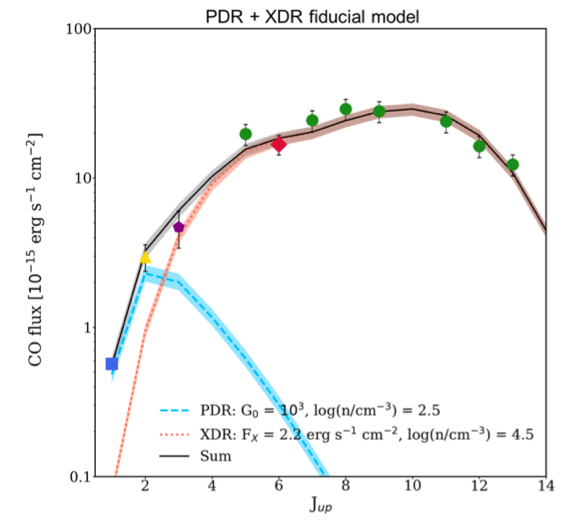CO excitation in the Seyfert galaxy NGC 34: stars, shock or AGN driven?
In the last decades, intensive observational and theoretical investigations have demonstrated how the Star Formation (SF) of galaxies and the Active Galactic Nuclei (AGN) phenomena are deeply connected. There are many observational pieces of evidence that support this connection, such as the tight relations between the super massive black hole (BH) mass and the host galaxy properties or the similar shape of the SF and the BH accretion density as a function of the cosmic.
In this context, Matilde Mingozzi – Ph.D. student at the University of Bologna and at the Arcetri Astrophysical Observatory – and her collaborators (including Giovanni Cresci from the Arcetri Astrophysical Observatory) have studied the local galaxy NGC 34, where the two phenomena co-exist. The main aim of their work is assessing whether and to what extent the molecular gas emission, traced mainly by carbon monoxide (CO), is influenced by the radiation produced by the accretion onto the BH. In fact, molecular gas is a key component of the interstellar medium (ISM), as it is the fuel of SF and possibly of AGN accretion. In particular, the so-called CO Spectral Line Energy Distribution (CO SLED) – i.e. the CO line luminosity as a function of the CO upper rotational level – is a fundamental tool to constrain the physical properties of the molecular gas, such as density, temperature and the main source that causes the emission.
In their work, they analyse the X-ray and CO emission, using mainly archival data from XMM-Newton, NuSTAR, ALMA, and Herschel. On the one hand, the X-ray data allow to properly include the effect of AGN radiation in the modelling of the CO SLED, on the other hand, the CO emission, traced by ALMA in the central region of NGC 34 at high spatial resolution, is crucial to spatially constrain the region where the contribution of the AGN actually dominates. In order to fit the shape of the CO SLED, they make use of grids of models of Photo-Dissociation Regions (PDRs) and X-ray Dominated Regions (XDRs) – i.e. regions whose physics and chemistry are dominated by far ultraviolet radiation due to young stars and X-ray radiation coming from the AGN, respectively. In addition, they take into account also a grid of shock models, since shocks, originated from the supersonic injection of mass into the ISM, can also compress and heat the gas.
 |
| Figure 1: Fiducial model (PDR + XDR) over-plotted on the observed data. The light-blue dashed line and the red dotted line represent the low-density PDR and the high-density XDR, respectively. The black solid line indicates the sum of the two components and the shaded areas indicate the ±1σ uncertainty range on the normalization of each component. Taken from Mingozzi et al (2017). |
In a recent paper, “CO excitation in the Seyfert galaxy NGC 34: stars, shock or AGN driven?” led by M. Minghozzi and accepted in MNRAS, the authors conclude that the AGN contribution is significant in heating the molecular gas in NGC 34 (Fig. 1 shows the best-fit of the CO SLED, composed by PDR and XDR components). Their results shed light on the great potential of combining self-consistent multi-band and multi-resolution data in order to assess the importance of AGN and SF activity, and mechanical heating produced by shocks for the physics of molecular gas.
Edited by M. Mingozzi and A. Gallazzi



